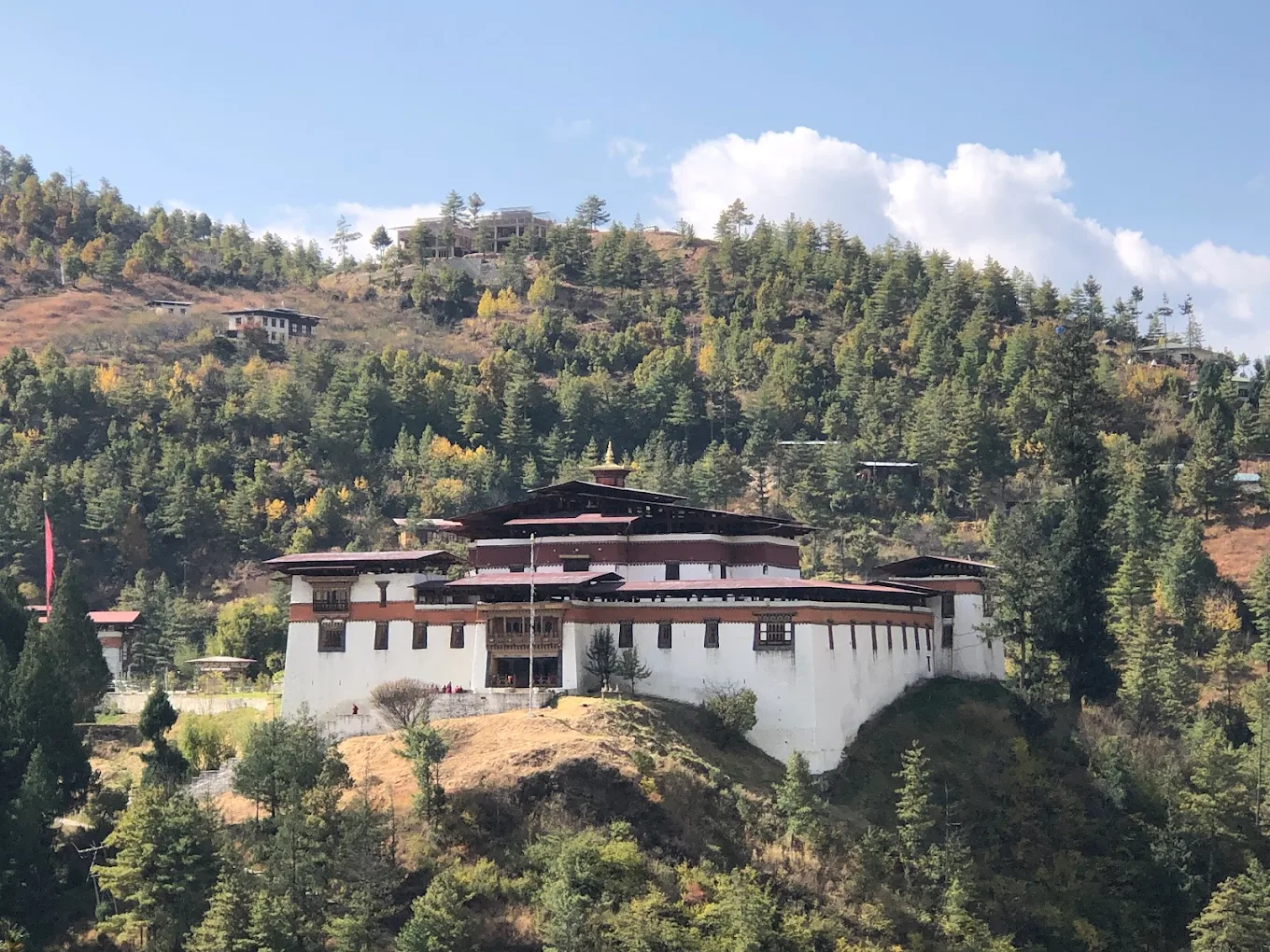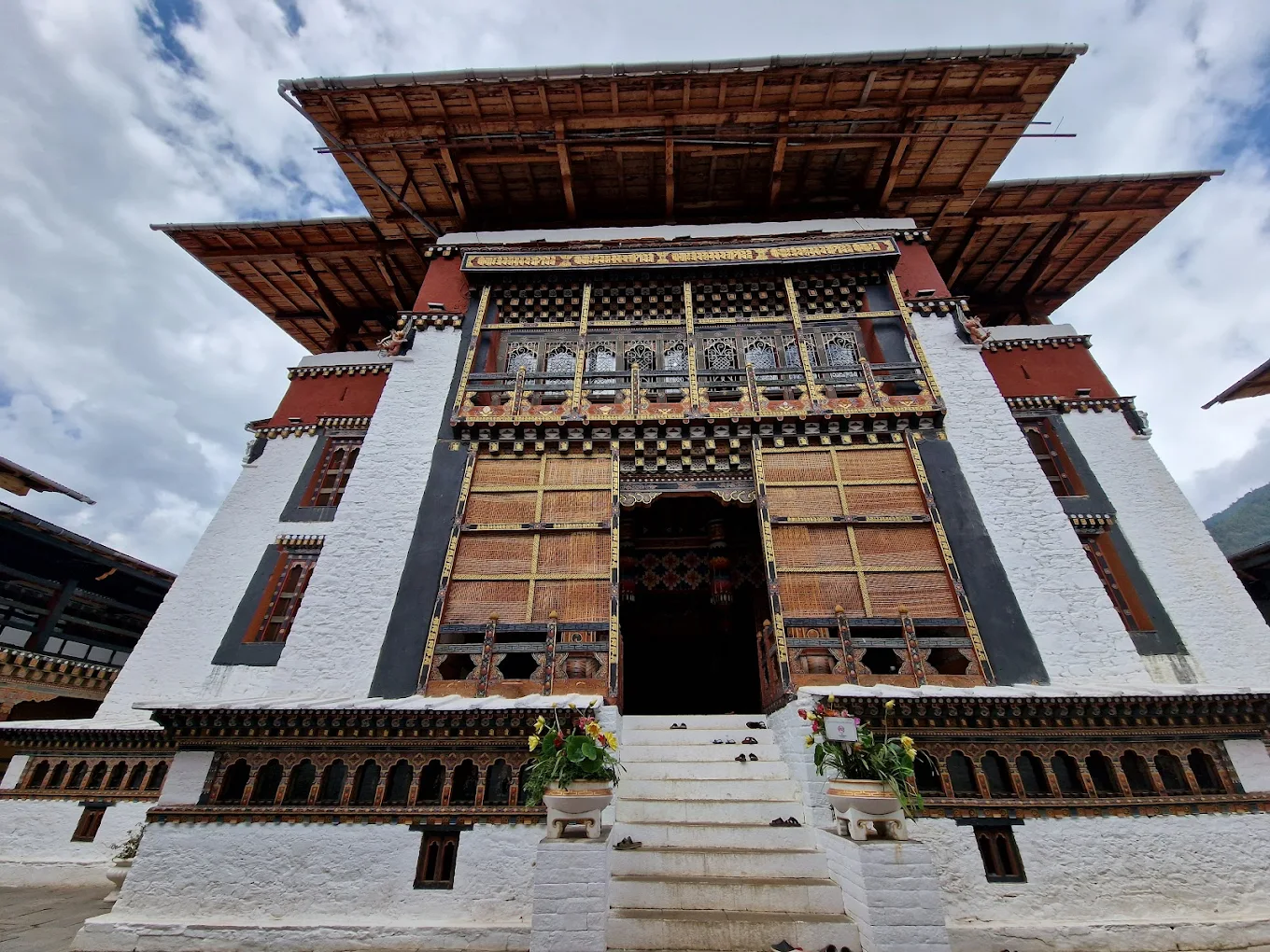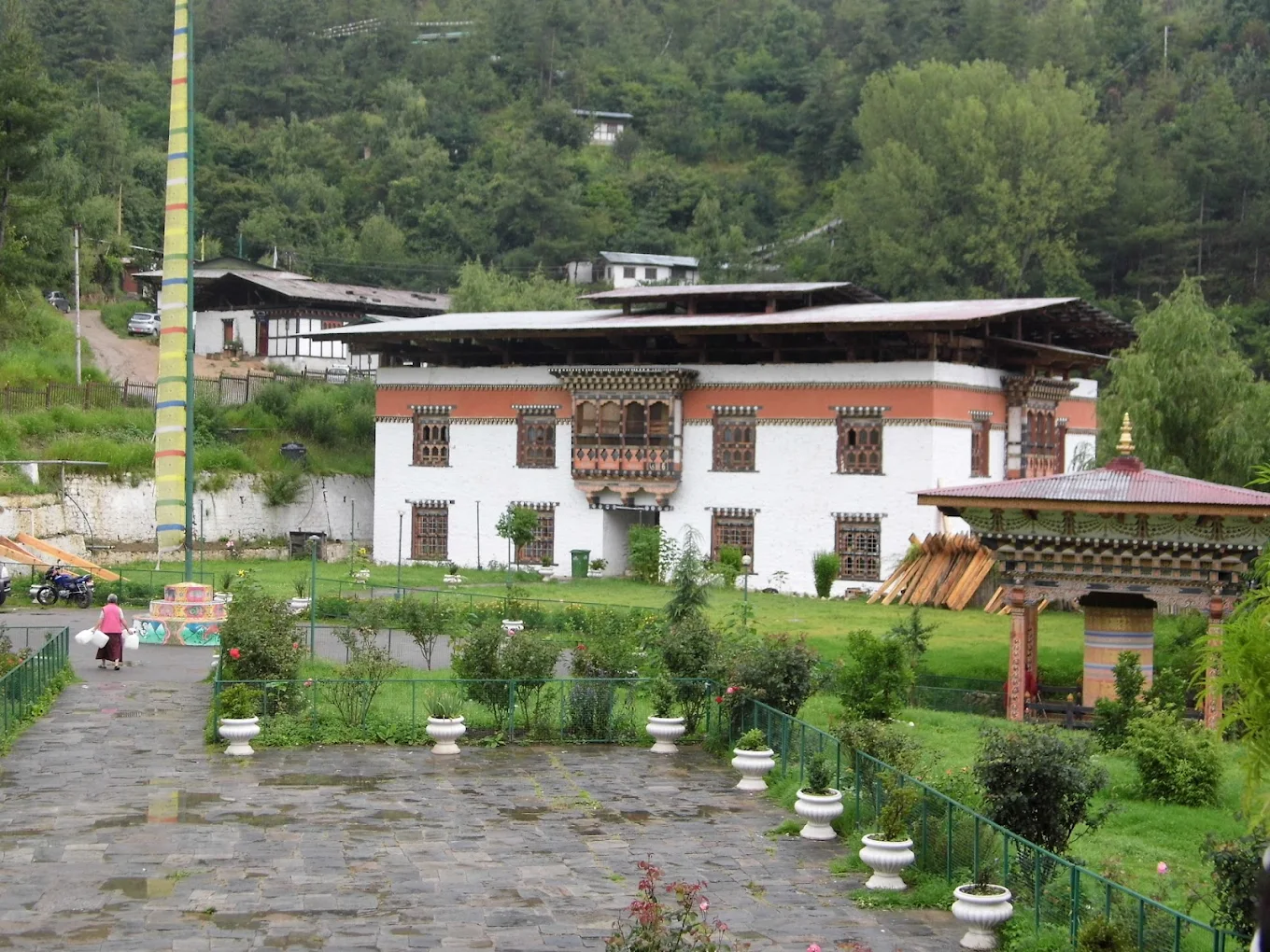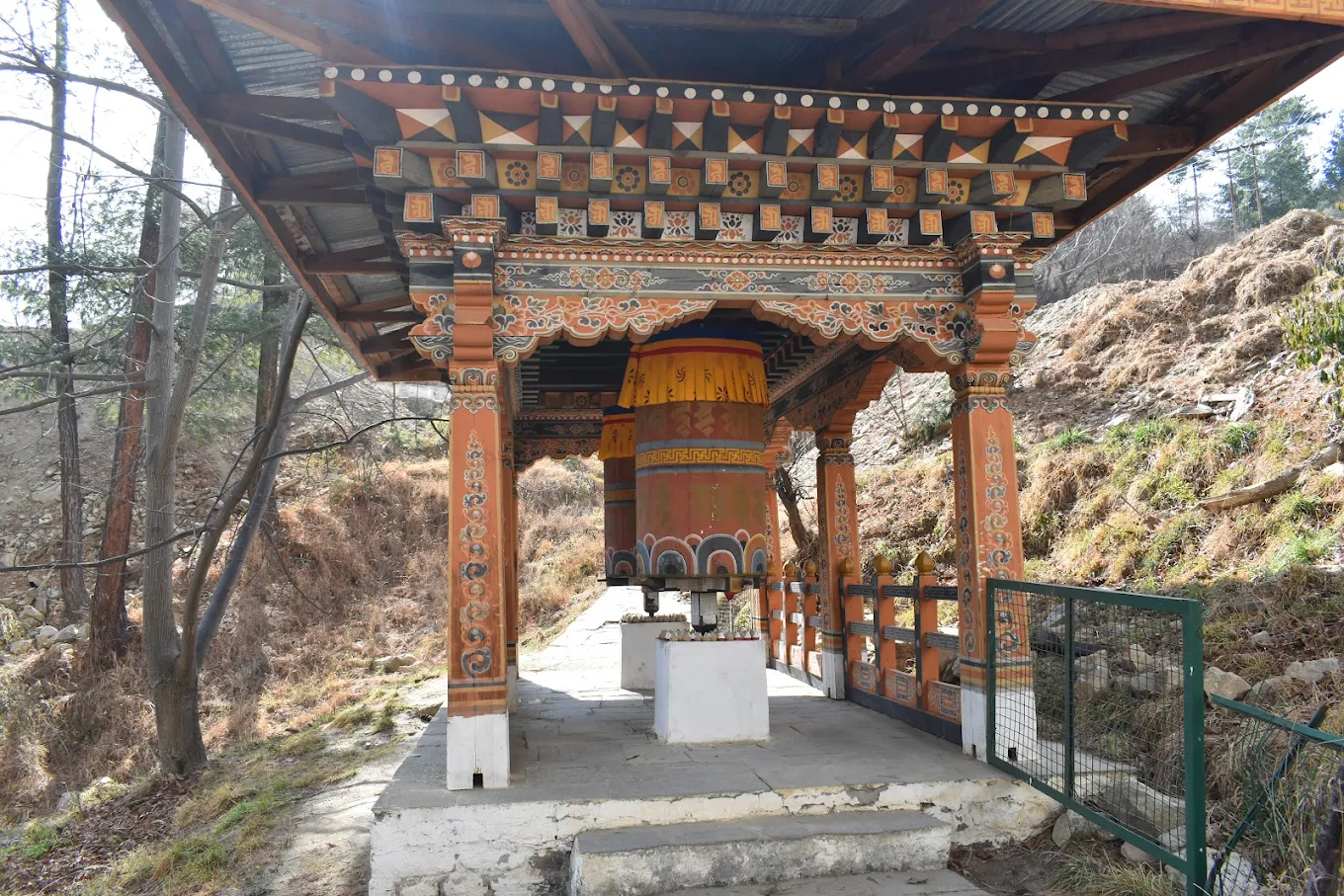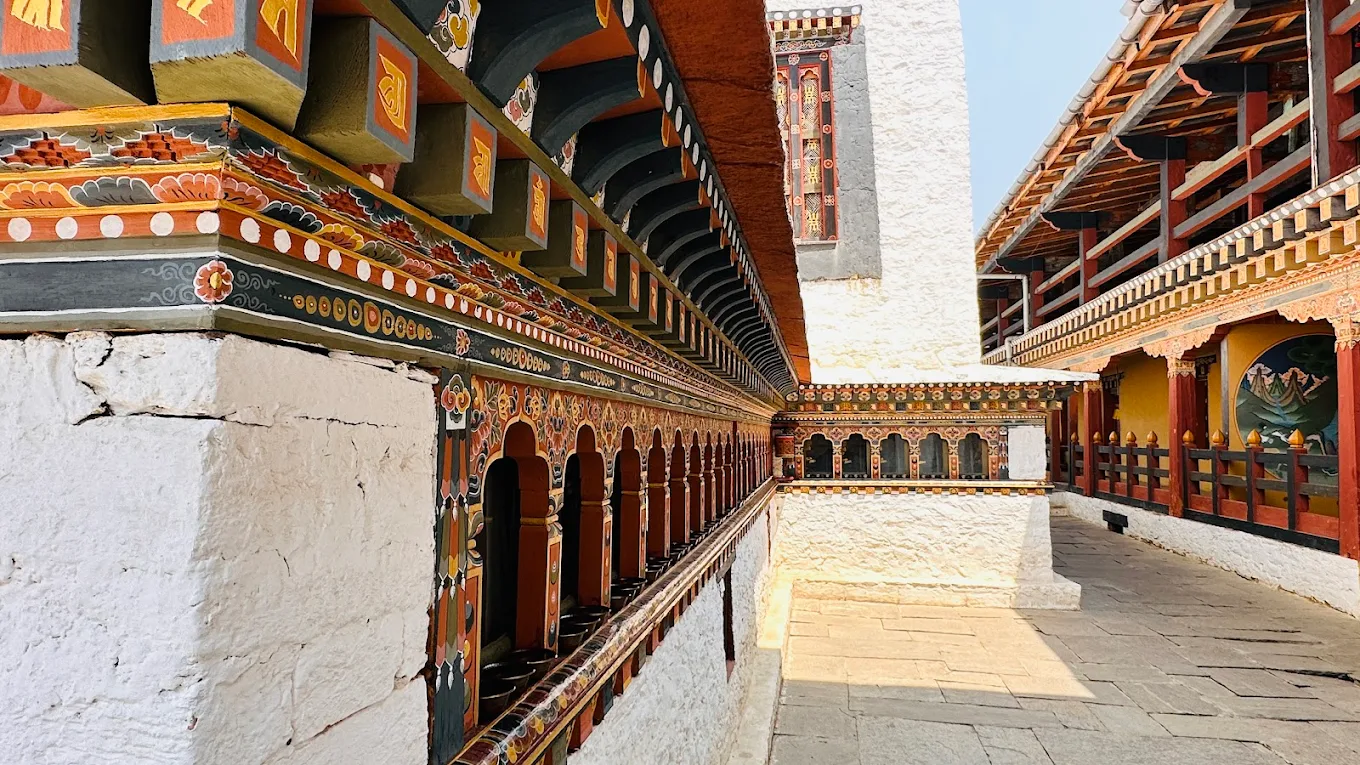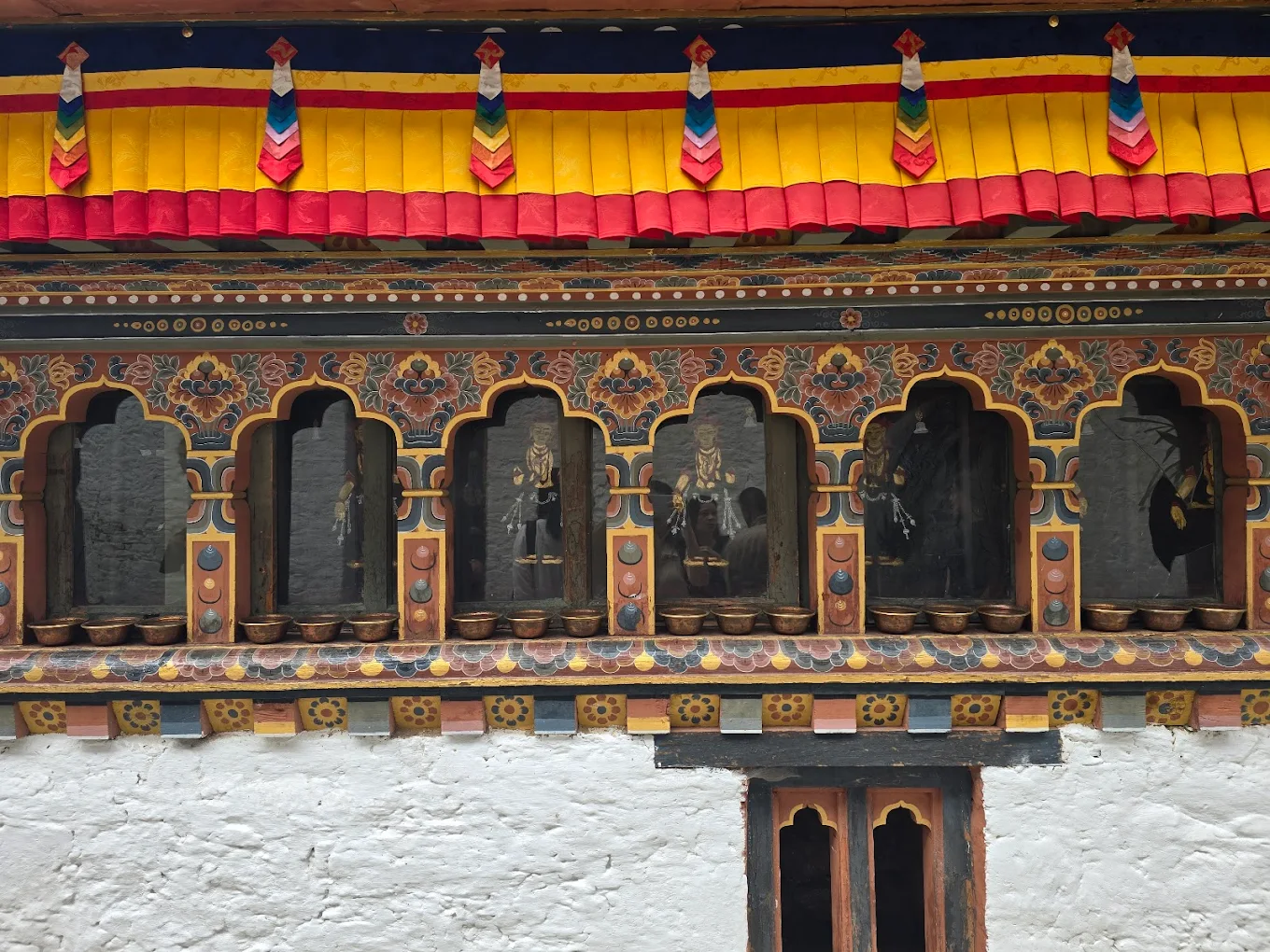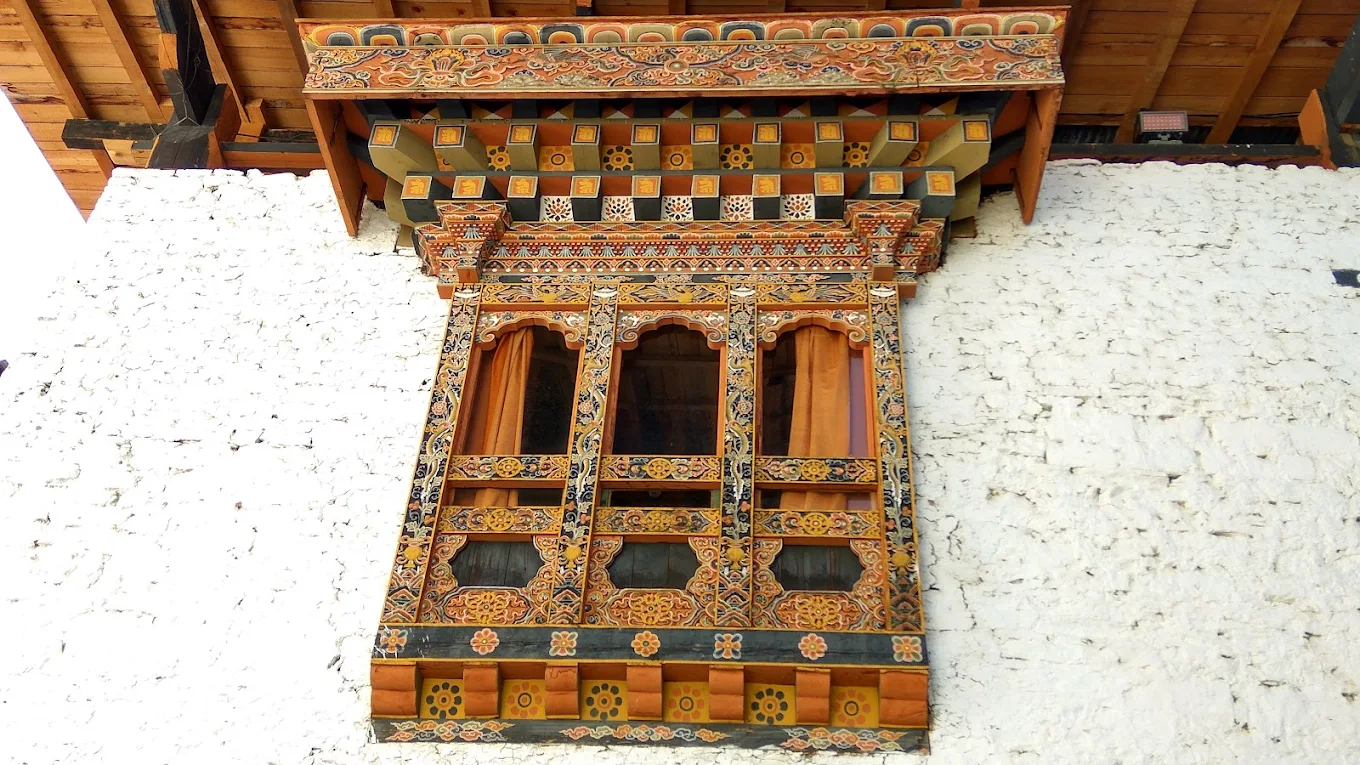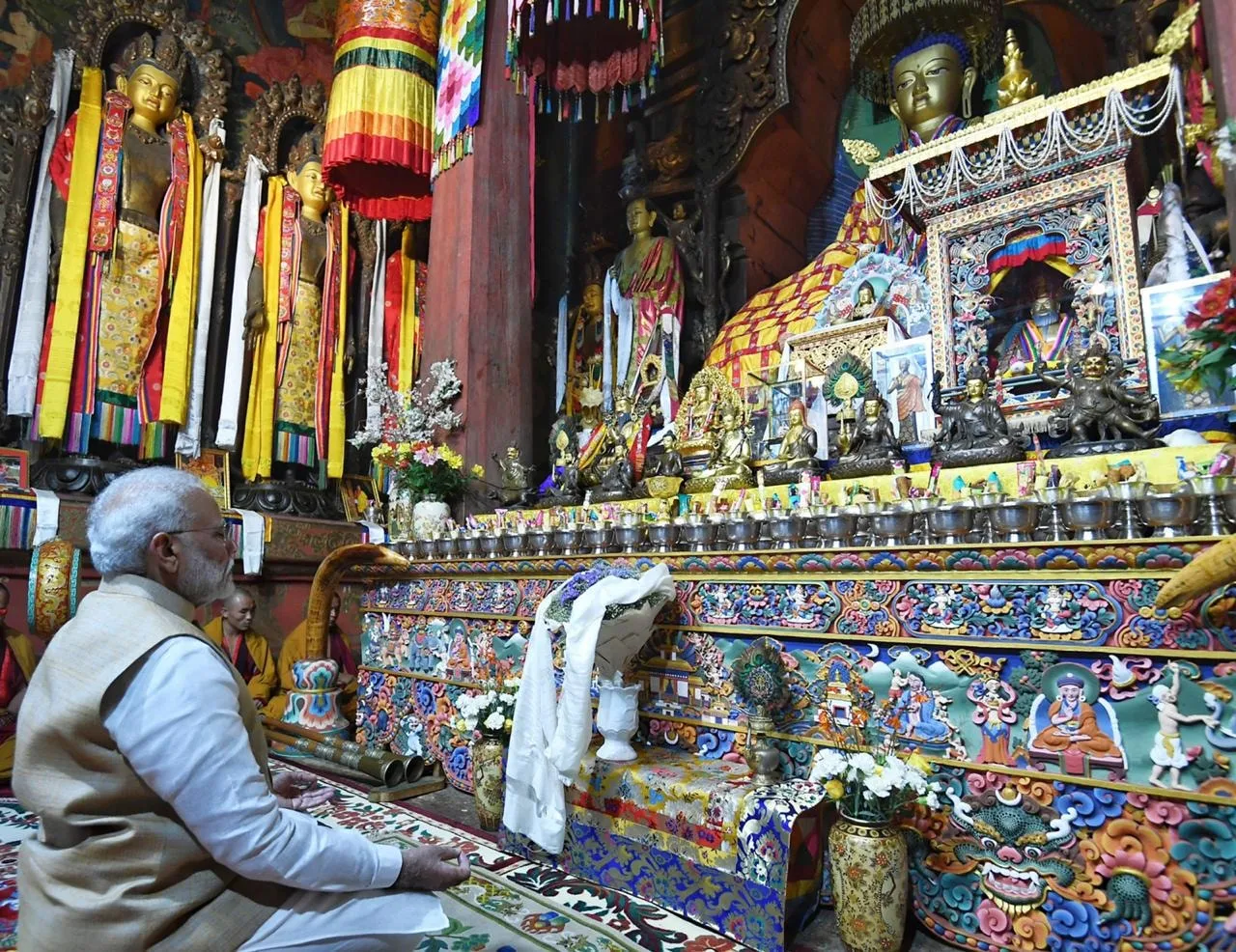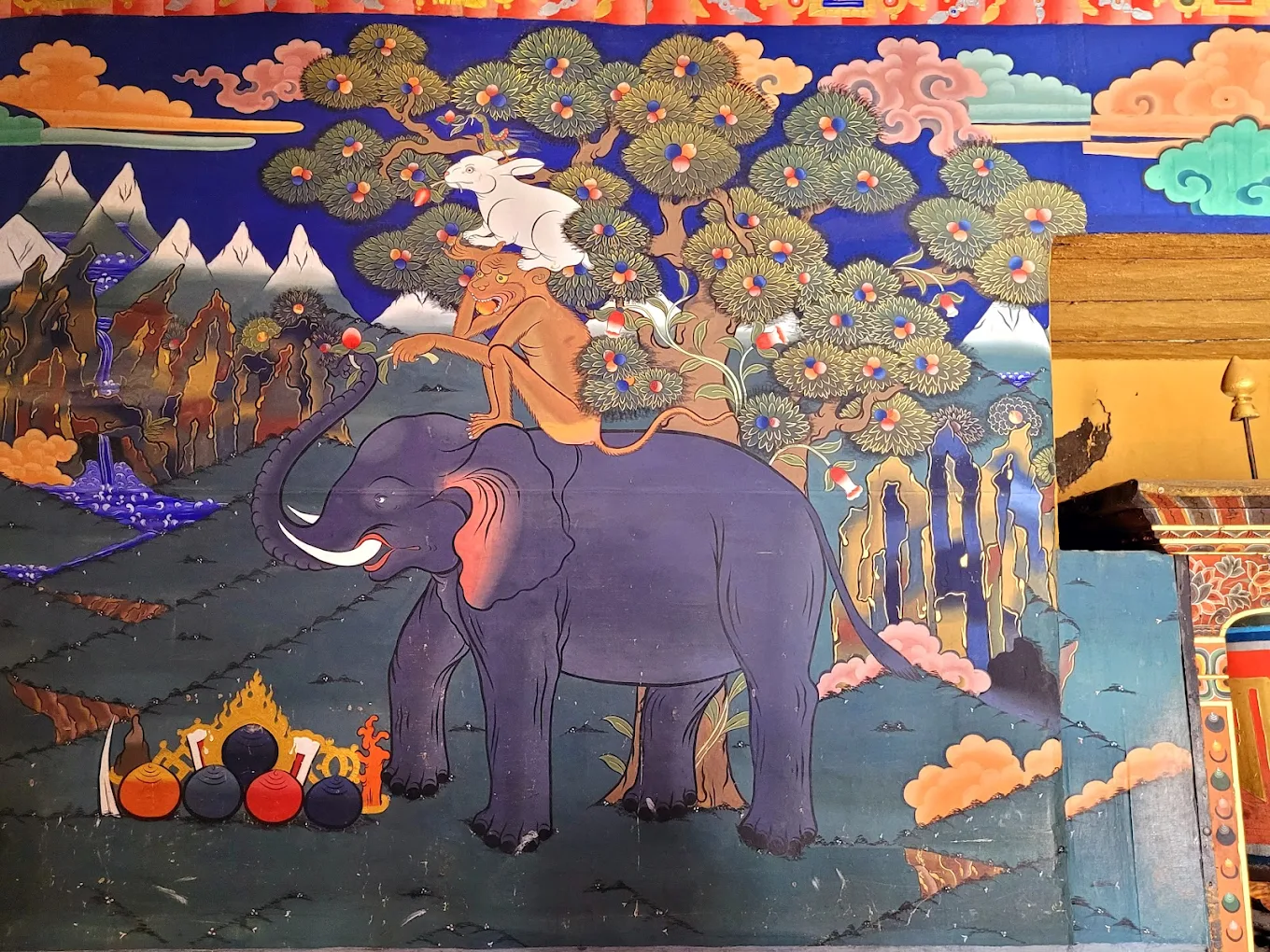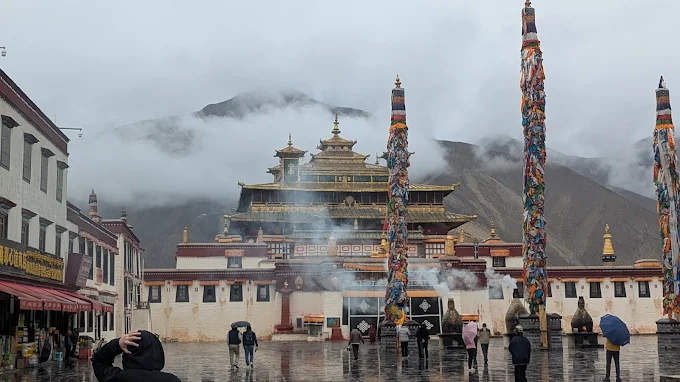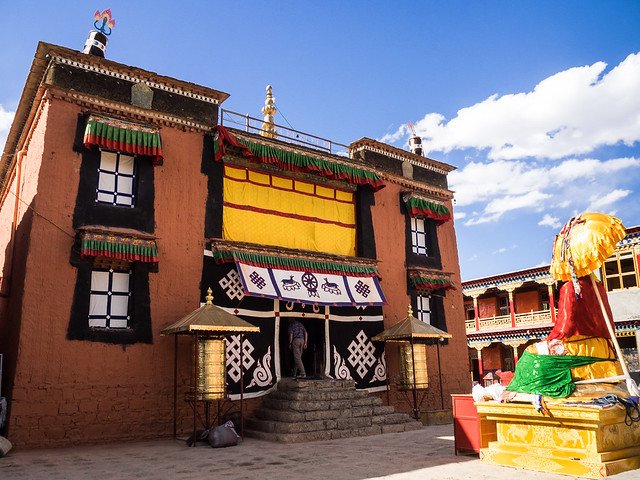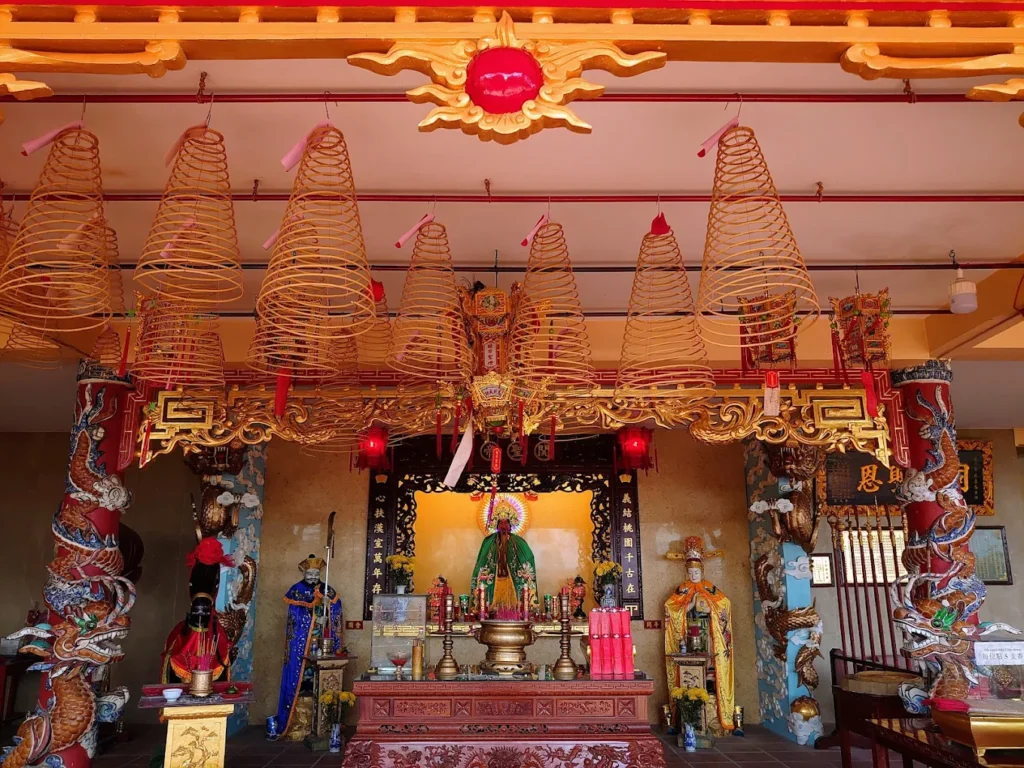Simtokha Dzong: The Ancient Fortress of Thimphu’s Drukpa Kagyu Legacy
At the gateway to Thimphu’s verdant valley, where the Wangchhu River carves through rocky cliffs, Simtokha Dzong stands as a sentinel of stone and history, its golden roof catching the morning sun. In the main temple (lhakhang), monks chant the Vajrakilaya mantra, their voices reverberating around a bronze statue of Guru Rinpoche, protector of Bhutan’s unity. Founded in 1629 by Zhabdrung Ngawang Namgyal, this Drukpa Kagyu fortress blends spiritual sanctity with military might, its thick walls guarding the entrance to Thimphu Dzongkhag. The air carries the scent of juniper incense, each stick lit to honor the dzong’s sacred role. Surrounded by prayer flags fluttering against the Himalayan breeze, the dzong overlooks the valley, tying devotion to Bhutan’s foundational spirit. This sacred haven beckons travelers, seekers, and scholars to explore its ancient halls and embrace the wisdom of Drukpa Kagyu.
Whispers of Fortitude: Overview and Significance
Introduction to Simtokha Dzong
Simtokha Dzong, perched at the southern entrance to Thimphu Dzongkhag, Bhutan, is a revered Drukpa Kagyu fortress, celebrated as the country’s oldest dzong and a center for Dzongkha language studies. A short walk from the Thimphu-Simtokha highway unveils a historic sanctuary where stone walls and golden roofs blend spiritual depth with architectural grandeur. Named “Simtokha” (meaning “on top of a demon”), it embodies Bhutan’s spiritual and political heritage, founded by Zhabdrung Ngawang Namgyal. A cultural and sacred landmark, the dzong weaves history, learning, and Himalayan reverence into a timeless refuge.
Historical Journey
Simtokha Dzong was established in 1629 by Zhabdrung Ngawang Namgyal, the unifier of Bhutan, to defend against invaders and establish Drukpa Kagyu dominance. Completed by 1631, it served as his initial administrative seat, its thick walls symbolizing strength. Damaged in 1630 by an explosion and rebuilt by 1633, the dzong withstood sieges and fires, notably in 1822. Transformed in the 20th century into the Institute of Language and Cultural Studies, it now trains scholars in Dzongkha, preserving Bhutan’s linguistic and spiritual legacy.
Cultural Significance
- Drukpa Kagyu Devotion: Rooted in the Drukpa Kagyu lineage, the dzong centers on Guru Rinpoche and Zhabdrung, emphasizing meditation and protection.
- Bhutanese Heritage: A spiritual and cultural anchor, it preserves rituals like mantra recitation and tsechu ceremonies, reflecting national identity.
- Educational Hub: The institute educates monks and laypeople in Dzongkha, shaping Bhutan’s cultural continuity.
- Regional Influence: Pilgrimages draw devotees from Thimphu and eastern Bhutan, fostering unity.
Unique Legacy
- Oldest Dzong: Built in 1629, it marks Bhutan’s first fortress-temple, a national treasure.
- Zhabdrung’s Vision: His meditation and governance here shaped Bhutan’s foundation.
- Linguistic Center: The institute preserves Dzongkha, Bhutan’s national language.
- Cultural Symbol: Its resilience reflects Bhutan’s spiritual and military heritage.
Community and Global Impact
- Local Devotion: The dzong hosts festivals and teachings, strengthening Bhutanese Buddhist ties.
- Pilgrimage Hub: Thousands visit annually, drawn by its historical and educational role.
- Global Appeal: International scholars and tourists seek its ancient architecture and language legacy.
- Cultural Dialogue: Shared rituals unite Bhutanese and global visitors, fostering understanding.
Modern Relevance
- Spiritual Retreat: Simtokha offers a haven for mindfulness amid history.
- Cultural Preservation: It safeguards Drukpa Kagyu practices and Dzongkha heritage.
- Educational Influence: The institute shapes Bhutan’s cultural and linguistic future.
Historical Anecdotes
- Zhabdrung’s Defense: The 1630 explosion tested his resolve, leading to its rebuild.
- Siege Survival: The dzong withstood attacks, symbolizing Bhutan’s strength.
- Language Revival: Its 20th-century role revitalized Dzongkha education.
Social Role
- Community Hub: Festivals and teachings unite Thimphu’s Buddhists.
- Educational Center: Monks and students learn Dzongkha, nurturing cultural roots.
- Charitable Spirit: Communal feasts reflect Drukpa Kagyu’s compassion.
Artistic Influence
- Bichu Paintings: Murals of Guru Rinpoche inspire Bhutanese art.
- Cultural Icon: The dzong’s silhouette graces local imagery.
- Festival Art: Cham dance costumes showcase Bhutanese craftsmanship.
Simtokha Dzong’s stone ramparts, rising above Thimphu’s southern gateway, weave a narrative of devotion and defense that defines Bhutan’s Drukpa Kagyu legacy. From Zhabdrung Ngawang Namgyal’s founding vision to its modern role as a language institute, the dzong’s history pulses with the spirit of Bhutan’s unification, uniting monks and scholars in pursuit of enlightenment. Its sacred lhakhangs and fortified walls set the stage for an architectural tapestry that mirrors its Himalayan soul. As we delve into its physical and spiritual features, Simtokha’s design reveals how its ancient beauty nurtures profound contemplation and cultural preservation.
Crafted by the Gateway: Architectural and Spiritual Features
Iconic Design
Simtokha Dzong’s architecture blends Bhutanese Drukpa Kagyu fortitude with its strategic valley setting, creating a sanctuary that harmonizes defense with devotion. Thick stone walls and golden roofs, adorned with prayer flags, rise from the 2,300-meter slope, reflecting Buddhist strength. The compact layout, centered on the main lhakhang, balances military function with spiritual purpose, with courtyards fostering community. Its perch at Thimphu’s entrance, overlooking the Wangchhu River, amplifies its sacred resonance, tying the dzong to Bhutan’s Himalayan ethos.
Key Structures
- Main Lhakhang: The spiritual core, housing Guru Rinpoche’s statue, built in 1631.
- Utse Tower: The central keep, a fortress within the dzong, symbolizes protection.
- Courtyard: A stone-paved space with incense burners, used for rituals.
- Institute Halls: Modern classrooms for Dzongkha studies, added in the 20th century.
- Chorten Cluster: Stone stupas honor Zhabdrung’s legacy, dotting the grounds.
- Prayer Wheel House: A small structure with mani wheels, spun by devotees.
- Guard Towers: Corner turrets, rebuilt post-1822 fire, enhance defense.
Worshipped Statues
- Guru Rinpoche (Padmasambhava): A bronze statue in the lhakhang, depicting meditation, embodies spiritual guidance.
- Zhabdrung Ngawang Namgyal: A gilt statue, symbolizing unity, radiates authority.
- Chenrezig (Avalokitesvara): A white stone statue, representing compassion, flanks the altar.
- Spiritual Role: Monks offer butter lamps to Guru Rinpoche and Zhabdrung, seeking protection and wisdom.
Materials and Techniques
- Construction: Local stone and timber, joined with Bhutanese techniques, ensure durability.
- Artistry: Bichu paintings and wooden carvings, crafted by Thimphu artisans, reflect Drukpa Kagyu symbolism.
- Cultural Essence: The design merges fortress practicality with monastic serenity, unique to early dzongs.
Signature Elements
- Utse Tower: The central keep, a symbol of Zhabdrung’s defense, anchors the dzong.
- Bichu Murals: Ancient paintings depict Guru Rinpoche’s miracles.
- Prayer Flags: Fluttering flags carry prayers across the valley.
Lesser-Known Features
- Hidden Passage: A tunnel beneath the dzong, used during sieges, remains sealed.
- Ancient Thangkas: Faded murals in the lhakhang show Vajrakilaya forms.
- Old Prayer Wheel: A weathered mani wheel, spun since the 17th century.
Preservation Efforts
- Restoration (1822): Rebuilt after a fire, preserving original design.
- Challenges: Monsoon erosion affects stonework, requiring care.
- Modern Additions: Solar lights enhance evening accessibility.
Environmental Integration
- Valley Harmony: The dzong’s design respects Thimphu’s river ecosystem.
- Eco-Practices: Monks maintain grounds and protect the Wangchhu watershed.
- Wildlife Haven: Birds nest nearby, enhancing serenity.
Artisan Narratives
- Mural Painters: Thimphu artists restored bichu paintings, preserving art.
- Stone Masons: Local craftsmen rebuilt walls, blending tradition.
- Flag Weavers: Nuns crafted prayer flags, embedding blessings.
Symbolic Details
- Utse Tower: Represents the Buddha’s body, guiding defense and spirit.
- Chortens: Symbolize enlightenment, honoring Zhabdrung.
- Bichu Murals: Depict tantric deities, inspiring meditation.
Landscape Integration
- Gateway Perch: Enhances strategic and spiritual focus.
- Wangchhu Views: The river’s flow mirrors inner calm.
- Pine Groves: Provide solitude and cultural resonance.
Simtokha’s stone lhakhangs and fortified towers, guarding Thimphu’s southern gateway, are more than architectural marvels; they are sanctuaries for the Drukpa Kagyu practices that define its unifying soul. The statues of Guru Rinpoche and Zhabdrung, illuminated by butter lamps, anchor rituals that connect monks to Bhutan’s spiritual lineage. These sacred spaces, alive with chants and study, invite visitors to engage with the dzong’s living traditions. As we explore its rituals, Simtokha’s role as a meditative and historical fortress comes to life, guiding devotees toward protection and enlightenment.
Rites of the Fortress: Rituals and Practices
Daily Sacred Rites
- Morning Chanting: Monks recite the Vajrakilaya mantra at dawn, fostering purification.
- Meditation Sessions: Silent meditation, held twice daily, centers on Mahamudra practices.
- Butter Lamp Offerings: Devotees light lamps before Guru Rinpoche, praying for protection.
Unique Practices
- Zhabdrung Commemoration: Monks meditate in the Utse tower, honoring his legacy.
- Dzongkha Chanting: Students recite prayers in Dzongkha, blending spirituality and language.
- Signature Ritual: Circumambulating the chorten cluster, tied to the dzong’s defensive history.
Festival Traditions
- Simtokha Tshechu (10th day, 6th lunar month): Cham dances and Guru Rinpoche offerings draw pilgrims.
- Lhabab Duchen: Ceremonies honor the Buddha’s descent, with chorten circuits.
- Losar (Bhutanese New Year): Monks perform purification rites, blessing visitors.
- Statue Veneration: Guru Rinpoche’s statue is adorned with silk during festivals.
Visitor Engagement
- Accessible Rituals: Visitors can join chants or circumambulate chortens, guided by monks.
- Offerings: Butter lamps and prayer flags, available at the dzong, invite participation.
- Drukpa Etiquette: Bow before statues and maintain silence during study.
Spiritual Community Roles
- Monastics: Over 100 monks and students lead rituals and learn Dzongkha.
- Scholars: Institute teachers guide language and philosophy studies.
- Lay Devotees: Thimphu villagers maintain grounds and offer supplies.
Interfaith Connections
- Syncretic Practices: Some blend Buddhist rites with Bon offerings, honoring local spirits.
- Outreach: Festivals welcome diverse faiths, fostering unity.
- Education: Monks share Drukpa Kagyu teachings with visitors.
Ritual Symbolism
- Butter Lamps: Dispel ignorance with wisdom’s light.
- Chorten Circuits: Represent devotion’s protective path.
- Cham Dances: Enact spiritual victory over obstacles.
Seasonal Variations
- Summer Rites: Vibrant with wildflowers, ideal for Simtokha Tshechu.
- Winter Study: Cold enhances institute focus.
- Monsoon Chants: Rain amplifies mantra resonance.
Monastic Life
- Daily Routine: Monks rise at 4:00 AM for chants, meditation, and study.
- Community Service: Monks guide pilgrims and maintain lhakhangs.
- Training Hub: Students learn Dzongkha and Buddhist philosophy.
Simtokha’s rituals, from the Vajrakilaya mantra to Zhabdrung’s commemorative rites, breathe life into its fortified sanctuary, connecting devotees to the Drukpa Kagyu lineage. The dzong’s meditative practices, rooted in Bhutan’s unifying faith, invite visitors to engage with its spiritual heart, whether through chants or silent reflection. For travelers, these rites offer a glimpse into Thimphu’s sacred traditions, accessible within its ancient walls. As we turn to visitor information, Simtokha’s strategic setting guides practical planning, ensuring a meaningful journey to this historic haven.
Journey to the Gateway: Visitor Information
Navigating to Simtokha Dzong
- Location: Southern Thimphu Dzongkhag, 2,300 meters, 5 km from Thimphu center along the Thimphu-Simtokha highway.
- Landmarks: Near the Institute of Language and Cultural Studies, with clear Dzongkha and English signs.
- Routes: Walk or drive from Thimphu’s center via the highway, a short distance.
Address of Simtokha Dzong
- Dzongkha: Simtokha Dzong, Thimphu Dzongkhag, Bhutan.
- English: Simtokha Dzong, Thimphu District, Bhutan.
Visiting Hours and Etiquette
- Hours: Open daily, 9:00 AM–5:00 PM, with study sessions paused midday.
- Etiquette: Dress modestly, remove shoes before lhakhangs, and avoid disturbing classes.
- Drukpa Custom: Offer butter lamps with both hands and bow to statues.
Transport Options
- By Foot: A 30-minute walk from Thimphu center along the highway.
- By Taxi: Drive directly to the dzong’s entrance.
- By Bicycle: A scenic ride suits active visitors.
Accessibility and Safety
- Mobility: Flat grounds are accessible; some stairs may challenge mobility issues.
- Safety: Well-maintained paths and staff presence ensure security.
- Tips: Wear comfortable shoes for indoor exploration.
Amenities and Surroundings
- Facilities: Restrooms and a small library offer texts and seating.
- Nearby: National Memorial Chorten and Tashichho Dzong, within 6 km, offer cultural experiences.
- Dining: Vegetarian meals at Thimphu’s eateries, like Simply Bhutan, nearby.
Immersive Visitor Tips
- Best Timing: Morning visits offer quiet chants and cooler weather.
- Sensory Moments: Inhale juniper-scented air and hear mantra recitations.
- Statue Connection: Offer butter lamps to Guru Rinpoche and reflect briefly.
- Festival Planning: Attend Simtokha Tshechu for cham dances.
Nearby Cultural Experiences
- National Memorial Chorten: A sacred stupa, 5 km away, honors the third king.
- Tashichho Dzong: Thimphu’s fortress, 6 km away, blends history and spirituality.
- Changangkha Lhakhang: A hilltop monastery, 7 km away, offers scenic views.
Photography Tips
- Best Angles: Capture the Utse tower at sunrise for golden light.
- Respectful Shots: Avoid photographing students during classes without permission.
- Scenic Views: The courtyard offers stunning valley shots.
- Equipment: A smartphone or lightweight camera suffices.
The journey to Simtokha Dzong, guided by Thimphu’s southern gateway, is a pilgrimage that blends historical exploration with spiritual discovery, inviting visitors to engage with its Drukpa Kagyu traditions. The dzong’s lhakhangs and chortens, vibrant with chants and study, offer a window into Bhutan’s sacred heart, where unity feels tangible. Beyond its physical strength, Simtokha’s deeper cultural and spiritual significance enriches the experience, revealing the essence of Himalayan Buddhism. As we explore these insights, the dzong’s role as a beacon of protection and learning comes into sharper focus, deepening our connection to its sacred legacy.
Cultural and Spiritual Insights
Drukpa Kagyu Philosophy
Simtokha Dzong embodies Drukpa Kagyu’s core: compassion and wisdom through meditation and protection. Guru Rinpoche and Zhabdrung inspire devotees to transcend ego, reflected in chants and rituals. Mahamudra teachings emphasize direct realization, guiding monks toward enlightenment.
Environmental Spirituality
The dzong’s valley perch ties it to Himalayan reverence for nature. The Wangchhu’s flow and pine forests foster meditative calm, with offerings honoring local deities. The landscape invites reflection on harmony with the natural world.
Artistic Symbolism
Bichu murals depict Guru Rinpoche’s victories, symbolizing spiritual triumph. Chortens represent the Buddha’s mind, while prayer flags balance elements. These elements weave Drukpa Kagyu ideals into the dzong’s aesthetic.
Community Resilience
Built by Zhabdrung’s devotees, Simtokha reflects Bhutanese perseverance through sieges and fires. Its language institute showcases collective faith, sustained by volunteer-led efforts, uniting Thimphu’s Buddhists.
Environmental Stewardship
The dzong’s grounds foster Buddhist environmental ethics. Monks protect the Wangchhu watershed and trails, ensuring balance. Visitors are urged to honor the valley’s sanctity.
Meditative Practices
Drukpa Kagyu meditation, including Mahamudra, cultivates awareness. The lhakhang offers spaces for retreats, guided by monks, amplifying inner peace amidst Thimphu’s gateway.
Cultural Narratives
- Zhabdrung’s Legacy: Tales of his 1629 founding fuel devotion.
- Siege Stories: Monks share tales of defense, linking past and present.
- Festival Lore: Simtokha Tshechu dances carry ancient traditions.
Historical Context
- Unification Era: Zhabdrung’s work shaped Bhutan’s Buddhist identity.
- Defense History: Sieges tested the dzong’s resilience.
- Language Revival: Its institute revitalized Dzongkha culture.
Reflecting on the Journey
Simtokha Dzong, guarding Thimphu’s southern gateway, is a sanctuary where fortitude meets wisdom. Its lhakhangs and chortens, alive with Zhabdrung’s legacy, embody Bhutan’s Drukpa Kagyu soul, inviting all to seek enlightenment. The dzong’s walls, worn by centuries of pilgrims and scholars, tell a story of resilience and devotion, rooted in Himalayan faith. Whether meditating before Guru Rinpoche, exploring its ancient murals, or tracing Bhutan’s unifying heritage, visitors find a space to reflect and connect. As you depart, the Wangchhu’s murmur and prayer flags’ flutter linger, a reminder that peace is always within reach.
